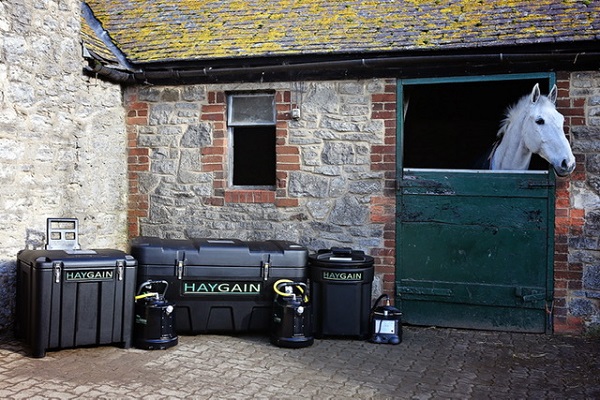Posted: 7th November 2019 | Back to news feed

As the first winter weather of the season arrives, horse health company Haygain share their expertise on how best to approach feeding when days are short, temperatures are cold, and exercise can be limited.

Feeding horses in winter can present a challenge for owners and riders. In summer, the grass provides a nutritious source of food that can be all that is needed for some equines to thrive. The body position, movement and methodical pattern of grazing is good for horses’ minds and bodies, but what happens when the grass stops growing, and mud begins to take over the countryside?
There are several factors to consider when you plan what to feed your horse or pony during the winter months, including their turnout regime, exercise levels, breed, body condition and age. Let’s run through them in more detail.
Are they living in or out?
Us humans are very quick to anthropomorphise our animals, and horses are no exception. Whereas we might look out at a dark field on a chilly night and decide a stable is better, lots of horses will thrive living out in winter if there is adequate shelter and they are left to grow a natural coat. Fresh air, space to move, socialising with field mates and natural ‘trickle feeding’ are all so good for equines. The digestion of long stem forage in the hind gut provides excellent ‘central heating’ for equines, so they stay toasty warm when the temperatures drop. It’s important to remember that winter grass has little nutritional value, so you’ll need to ensure a plentiful supply of dried forage and consider a feed balancer for essential vitamins and minerals.
Horses who are stabled will still need as much forage as possible to stay healthy and warm, but hay and beddings such as straw are the biggest sources of stable dust. To ease concern over the potentially harmful dust in hay, consider steaming it with a Haygain steamer to help protect your horse’s respiratory health. Haygain hay steamers are scientifically proven to kill mould, fungi, yeast and bacteria in hay and reduce up to 99% of respirable dust particles.”
What is their workload?
It might seem obvious, but a horse who overwinters with just a light hack once or twice a week will need a very different diet to a hunter or National Hunt racehorse who is in full work during these months. You also need to be aware of the more subtle changes in your horse’s work as you go into a winter routine and adjust feed quantities accordingly. Remember that any changes to an equine’s diet must be done gradually to allow their gut flora to adapt. As we have just mentioned, feeding ad lib steamed hay will go a long way to keep a horse in light work warm, content and if you add a feed balancer into the mix, healthy too.
Are they carrying any excess weight?
Equines have also evolved to put on weight in the summer in anticipation of losing it in the winter when food sources become scarcer. Heading into spring too fat and ‘well’ will put horses at a greater risk of metabolic disorders and joint issues.
The UK’s native breeds are particularly good at putting on weight easily, even in the depths of winter. Just think of those Shetland ponies perched on a windy hillside in Scotland with only wispy grass and heather as far as the eye can see – and still with a booty to be proud of! Most natives won’t need a rug or hard feed even in winter and adding these elements into your stable management routine means you risk your native getting porky.
As we’ve mentioned previously, ad lib hay is an ideal winter feedstuff for horses in light work or natives but if you’re worried that even that might cause weight gain, you can have forage analysed to identify the hay that has the lowest energy yield and feed that. If it’s poor quality then steaming it in a Haygain Steamer will kill off bacteria, moulds and fungi and remove dust particles, make it totally safe for all equines. Plus, feeding a high fibre diet comprised mostly of forage will help to reduce the risk of metabolic conditions.
There are other factors that can influence the feed requirements of horses in winter, such as their age and breed. If you’re not sure if your horse is getting the right nutrients or if they are the correct weight, speak to your vet. It’s key to remember your basic rules of feeding – feed according to work done, fibre first and make changes gradually.
The Equestrian Index newsfeed is compiled from articles submitted by advertising members and expresses the opinions of those members. Watsons Directories Ltd shall not be held liable for any inaccuracies or mis-statements therein.